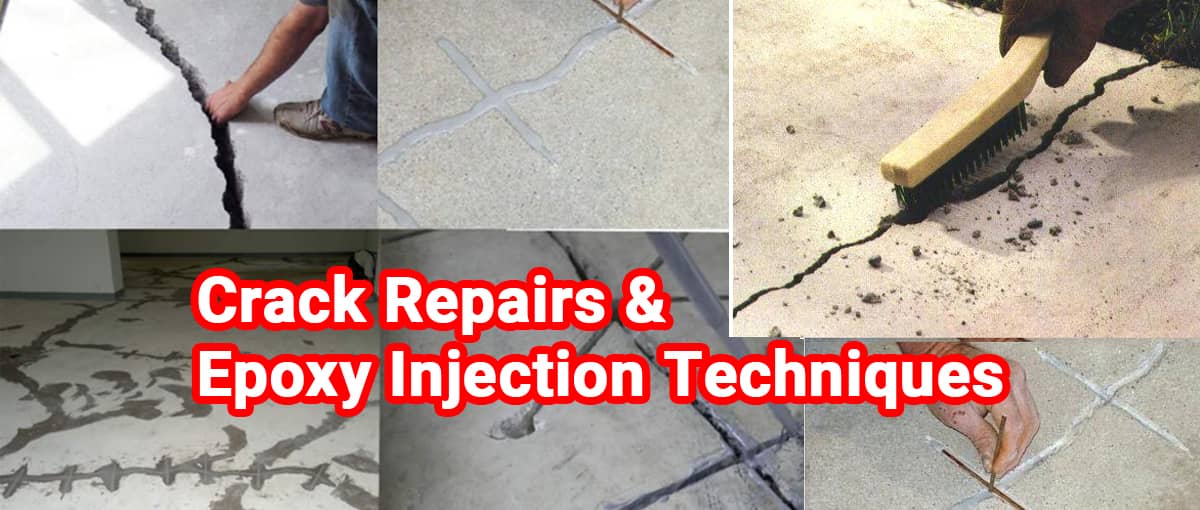Crack Repairs and Epoxy Injection Techniques

A number of methods are available to repair cracks in concrete, including epoxy injection, grouting and sealant, surface treatment & overlays.
The following steps describe the low-pressure crack injection techniques that can seal structural cracks in a structure. It is important to keep in mind that the kind of epoxy and the injection time necessary will vary with every project based on the crack size, wall thickness, and other factors. In addition, crack repair kits will be available that come complete with tools and supplies needed to complete the project.
8 Crack Repair Tips
- If necessary, increase the injection pressure from a low setting.
- Epoxy injection pressure needs to increase for the larger cracks.
- Wait a short time, not too long, before filling large cracks in concrete, making sure that the epoxy fills the crack.
- A pencil can use to seal any leaks in the upper seal. A small area with leaks should only be treated this way.
- Use a chisel or scraper to remove the upper seal. The epoxy paste can also be removed with a heat gun.
- Caulk should be applied at least eighteen inches from the edge of a narrow crack. That gives you a place where the epoxy can be applied, minimizing waste.
- Reinforcing bars have been inserted and bonded into place with epoxy to repair cracked reinforced concrete bridge girdles.
- The crack is sealed, holes are drilled that intersect the crack plane at approximately 90 degrees, epoxy is injected into the hole and crack, and a reinforcing bar is placed into the hole drilled.
Epoxy Injection Method
Repairing fine and hairline cracks in horizontal, vertical, and overhead surfaces of concrete floors, slabs, walls, panels, columns, beams, soffits, curbs, and other elements of concrete is possible with this method. Brickwork and masonry cracks can also be treated with this method.
Process of Injecting Epoxy into Cracks
Using a rake or high-pressure air, remove all debris from the crack. Apply surface sealer or adhesive directly over the crack to adhere the injection flanges to the concrete surface at 300mm centers. Keep the flange aperture free of adhesive by using a rod to locate the crack. Cover the exposed crack with adhesive.
Fill the empty cartridge with the epoxy mixture. Work your way along the crack with the plastic hose and flange, inserting epoxy along the crack. Stop when the epoxy cannot be filled any further. After the epoxy has hardened, remove the flanges and grind the concrete if necessary to a smooth finish.
Sealing of Cracks & Grouting
A joint sealant fills and seals the crack by enlarging the crack along with its exposed faces.
Pavements and floors benefit from this product. In addition to horizontal surfaces, it uses in curved surfaces. Sealing cracks and prevents water from reaching the reinforced steel, which is also used in places where water is standing.
Sealants can make from ethane, epoxy, silicone, poly-sulfides, asphaltic materials, and polymer mortars. Cracks can occur when using cement grouts. If the sealants are to use on floors, they have to be rigid enough to withstand traffic pressure and not brittle at all.
Surface treatment
A crack may also undergo surface treatment if epoxy or grouting has already been completed. Additionally, resin-based systems with low solids and low viscosities have helped seal concrete surfaces less likely to wear out.
Overlays
Concrete or silica fume concrete overlay can be applied to slabs that contain dormant cracks. Overlays can also be applied to slabs with cracks that are presently working, but joints must be placed directly over the cracks.
For more information please watch the tutorial
